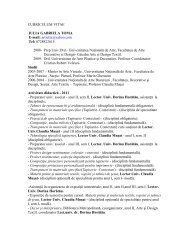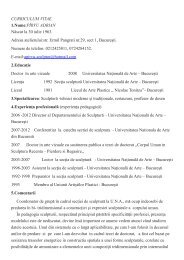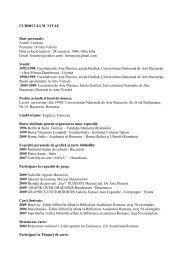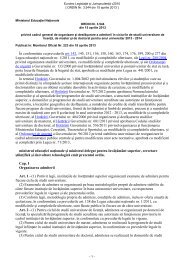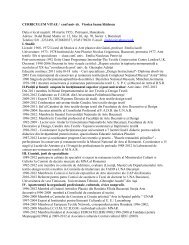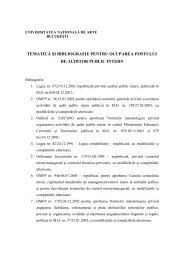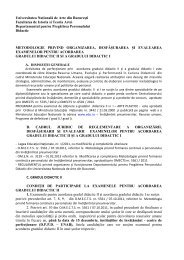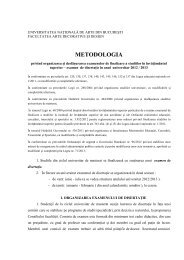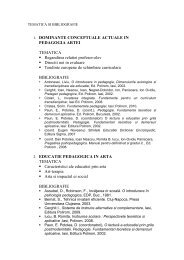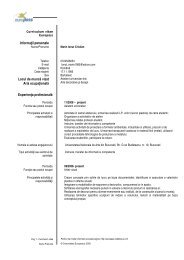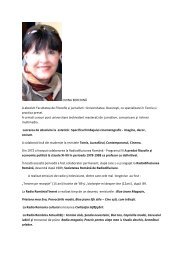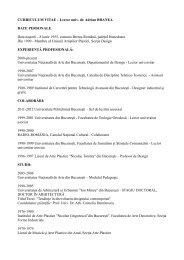- Page 1:
Editura “UNARTE”2006
- Page 7:
CUPRINSPrefaţăArgumentIntroducere
- Page 11 and 12:
PREFAŢĂPROF. UNIV. DR. MIHAI MĂN
- Page 13 and 14:
de un prinţ sau o imagine multipli
- Page 15:
Fig. 1. MIhail Mănescu. “Ambigui
- Page 18 and 19:
ArgumentFig. 4. Deutsche Illustrirt
- Page 20 and 21:
IntroducereFig. 9. Galestruzzi Trop
- Page 22:
Fig. 17. Ilustraţie de G.Dore şi
- Page 26:
Cap. I. 1.Atributele fundamentale a
- Page 29 and 30:
I.2. materialitatea în sine a semn
- Page 31 and 32:
I.3.Repere istorice ale temeimateri
- Page 33 and 34:
picturi le îngăduia unor persoane
- Page 35 and 36:
Qattrocento-ul la PadovaO figurare
- Page 37 and 38:
subiectelor. În plus, atmosfera po
- Page 39 and 40:
Secolul al XIX-lea în FranţaHonor
- Page 43 and 44:
Cap. II.Gravura între aplicativita
- Page 45 and 46:
şi apreciat, servit de artişti de
- Page 47 and 48:
II.2.Condiţia gravurii în perspec
- Page 49 and 50:
Puţine dintre ele sunt semnate şi
- Page 51 and 52:
anonime din capodopera tipografică
- Page 53 and 54:
Chinuitele sfâşieri ale fibrei le
- Page 55 and 56:
gravura. (Maestrul Cabinetului din
- Page 57 and 58:
În Ţările de Jos, tehnica aquafo
- Page 59 and 60:
timpului său, aşezat de admirator
- Page 61 and 62:
Un alt procedeu care a servit o rut
- Page 63 and 64:
În 1722, germanul de origine franc
- Page 65 and 66:
Fig. 78. Edouard Manet. 1832-83. Il
- Page 67 and 68:
SerigrafiaEste tehnica de imprimare
- Page 69 and 70:
Fig. 97. Andrew Stasik. “Steaguri
- Page 71 and 72:
MonotipulCa tehnică de imprimare e
- Page 73 and 74:
Edgar Degas (Fig. 109) şi-a găsit
- Page 77 and 78:
Cap. III.Viziune istorică asupra t
- Page 79 and 80:
nierelor gravuriiajutorul căreia s
- Page 81 and 82:
III. 1. Principiile fundamentale al
- Page 83 and 84:
În xilogravura - lemn în fibră,
- Page 85 and 86:
categoria tiparului adânc:pointe s
- Page 87 and 88:
Această noutate a făcut posibilă
- Page 89 and 90:
AquaforteÎn tehnica aquaforte, sem
- Page 91 and 92:
Pointe-secheÎn tehnica Pointe-séc
- Page 93 and 94:
Gravura în dăltiţăCa şi în te
- Page 95 and 96:
Pe lângă aceasta, în gravurile s
- Page 97 and 98:
Maniera verniului moale( eng. soft
- Page 99 and 100:
Maniera zahărului ( eng. lift-grou
- Page 101 and 102:
GRAVURA ÎN ADÂNCIME COLORATĂ- am
- Page 103 and 104:
În cadrul acestui tip de tipar gă
- Page 105 and 106:
Maniera laviului şi a peniţeiEste
- Page 107 and 108:
Maniera neagrăProcedeu prin care s
- Page 109 and 110:
FotolitografiaÎn acest caz avem de
- Page 111 and 112:
Zincografia (zincogravură)Pentru a
- Page 113 and 114:
Serigrafie - serigravurăAvem de-a
- Page 115 and 116:
evident automatizate prin instalaţ
- Page 117 and 118:
categoria tiparului în sectimbrul
- Page 119 and 120:
Dacă ne întoarcem la domeniul gra
- Page 121 and 122:
categoria tiparului unicmonotipMONO
- Page 123 and 124:
1. Alegerea materialuluiSe foloseş
- Page 125 and 126:
categoria tiparului electronicelect
- Page 127 and 128:
făcut posibilă juxtapunerea mult
- Page 129 and 130:
categoria tiparului fotograficfotog
- Page 131 and 132:
MATERIALITATEA ÎN GRAVURĂ131
- Page 133 and 134:
MATERIALITATEA ÎN GRAVURĂ133
- Page 135:
MATERIALITATEA ÎN GRAVURĂ135
- Page 138 and 139:
Florin STOICIU
- Page 140 and 141:
Cap.IV. Înalta specificitate a gra
- Page 142 and 143:
Cap.IV. Înalta specificitate a gra
- Page 144 and 145:
Cap.IV. Înalta specificitate a gra
- Page 146 and 147:
Cap.IV. Înalta specificitate a gra
- Page 148 and 149:
Cap.IV. Înalta specificitate a gra
- Page 150 and 151:
Cap.IV. Înalta specificitate a gra
- Page 152 and 153:
Cap.IV. Înalta specificitate a gra
- Page 154 and 155:
Cap.IV. Înalta specificitate a gra
- Page 156 and 157: Cap.IV. Înalta specificitate a gra
- Page 158 and 159: Cap.IV. Înalta specificitate a gra
- Page 160: Cap.IV. Înalta specificitate a gra
- Page 165 and 166: Cap.V. Elemente de seducţie vizual
- Page 167 and 168: Cap.V. Elemente de seducţie vizual
- Page 169 and 170: În 751 a început fabricarea ei la
- Page 171 and 172: calitate, acest lucru fiind făcut
- Page 173 and 174: Cap.V. Elemente de seducţie vizual
- Page 175 and 176: V.2. Cerneala tipografică, element
- Page 177 and 178: Cap.V. Elemente de seducţie vizual
- Page 179 and 180: Cap.V. Elemente de seducţie vizual
- Page 181 and 182: spală cu benzină, devine şi mai
- Page 183 and 184: Cap.V. Elemente de seducţie vizual
- Page 187 and 188: GLOSARGLOSARABRAZIVCorp sau materia
- Page 189 and 190: GLOSARnumim de “zgâriere”.a gr
- Page 191 and 192: GLOSARCREION, creioane,Ustensilă p
- Page 193 and 194: GLOSAR EMULSIE, emulsii,Amestec dis
- Page 195 and 196: GLOSARGRAVURA ÎN ADÂNCIME - Săpa
- Page 197 and 198: OFSET- procedeu de imprimare în ca
- Page 199 and 200: SOLVENTSubstanţă chimică (lichid
- Page 201: VERNISSoluţie formată din răşin
- Page 204 and 205: and tactile seductions. As such, we
- Page 208 and 209: materiality. Moreover, even when we
- Page 210 and 211: the presence of printmaking also po
- Page 212 and 213: Index II. Performanţele tehnicilor
- Page 214 and 215: Pag. 32. Fig. 5. Bacantă dansând,
- Page 216 and 217: Pag. 56. Fig. 39. Urs Graf. Femeie
- Page 218 and 219: S.U.A.Pag. 68. Fig. 95. Theophile S
- Page 220 and 221: Pag. 98. Fig. 46.Florin Stoiciu.
- Page 222 and 223: Pag. 129. Fig. 124. Carmen Apetrei.
- Page 224: V. 4. Câteva materiale şi scule s
- Page 228 and 229: Portofoliu Florin StoiciuACTIVITATE
- Page 230 and 231: Portofoliu Florin Stoiciu230Florin
- Page 232 and 233: Portofoliu Florin Stoiciu232Florin
- Page 234 and 235: Portofoliu Florin Stoiciu234Florin
- Page 236 and 237: Portofoliu Florin Stoiciu236Florin
- Page 238 and 239: Portofoliu Florin Stoiciu238Florin
- Page 240 and 241: Portofoliu Florin Stoiciu240Florin
- Page 242 and 243: Portofoliu Florin Stoiciu242Florin
- Page 245 and 246: BIBLIOGRAFIEBIBLIOGRAFIE“A Histor
- Page 247 and 248: BIBLIOGRAFIEMĂNESCU Mihai - “Teh
- Page 249 and 250: MATERIALITATEA ÎN GRAVURĂMulţume



